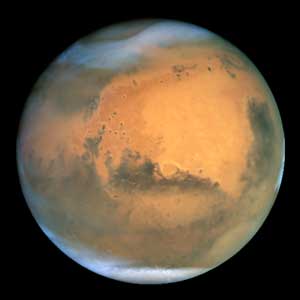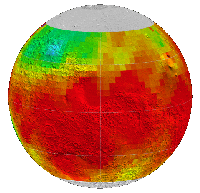

JET PROPULSION LABORATORY
CALIFORNIA INSTITUTE OF TECHNOLOGY
NATIONAL AERONAUTICS AND SPACE ADMINISTRATION
July 9, 2001
"This is by far the largest storm we've seen during the Mars Global Surveyor mission," said Dr. Philip Christensen of Arizona State University in Tempe, principal investigator for the Global Surveyor's thermal emission spectrometer. The instrument has been monitoring the Martian atmosphere since March 1999. "We expect that the storm will continue to grow -- perhaps becoming a global storm of the type that was seen during the Mariner 9 and Viking missions in the 1970s," Christensen said.
Daily observations by the instrument are made into maps that allow scientists to determine both the temperature and the amount of dust in the atmosphere. Mars dust storm maps are posted at http://tes.la.asu.edu.
Scientists first noticed the onset of the storm June 15, 2001 when a region of dust began to appear in the Hellas Basin in the southern hemisphere. A week and a half later, on June 26, the storm began to intensify and expand. Since then, the storm has dramatically grown in size and severity. The dust storm has expanded well into the northern hemisphere and has wrapped more than halfway around the planet, Christensen said. This storm also began earlier than normal for Martian dust storms. In the past when a large storm has occurred early in the season, there are usually several large storms during the year. NASA scientists will be monitoring Mars over the next few months to see how this major storm develops and to test their predictions of more storms to come.
The storm should not have a major impact on the planned arrival of another spacecraft, the 2001 Mars Odyssey, in October, Christensen said. Odyssey will use repeated passes through Mars' upper atmosphere to slow the spacecraft and lower its orbit around the red planet. "We'll use the instruments on Global Surveyor to monitor the atmosphere on an hourly basis, providing the Odyssey spacecraft team the information they need to keep Odyssey at the proper height where it can safely fly through the atmosphere," Christensen said. Odyssey's orbit height can be adjusted as needed in response to the changing atmosphere as observed by Global Surveyor, he said.
For more information on the Mars Exploration Program, see http://mars.jpl.nasa.gov.
Global Surveyor was launched in November 1996, and Mars Odyssey was launched in April 2001. Both missions are managed by JPL for NASA's Office of Space Science, Washington, D.C. Lockheed Martin Astronautics, Denver, Colo., developed and operates both spacecraft. The thermal emission spectrometers on each spacecraft are operated by Arizona State University. JPL is a division of the California Institute of Technology in Pasadena.
July 5, 2001
Image Credit: NASA and the Hubble Heritage Team (STScI/AURA) Acknowledgment: J. Bell (Cornell U.), P. James (U. Toledo), M. Wolff (Space Science Institute), A. Lubenow (STScI), J. Neubert (MIT/Cornell)
NASA Science News for June 21, 2001
=========================================================== SKY & TELESCOPE'S NEWS BULLETIN - JUNE 15, 2001 =========================================================== For images and Web links for these items, visit www.skypub.com ===========================================================
Dobbins organized an expedition to the Florida Keys, where Mars would climb high in the south under exceptionally steady skies. Team members from SKY & TELESCOPE and the Association of Lunar and Planetary Observers (ALPO) scrutinized the planet using a variety of telescopes nightly beginning June 5th. No flares were seen for the first two nights. But on June 7th, beginning around 06:35 Universal Time (2:35 a.m. Eastern daylight time), about 85 minutes before Edom crossed the central meridian, Dobbins and his colleagues observed a series of brightenings. Each lasted 3 to 5 seconds; they occurred once or twice a minute over the next hour and a half, until clouds ended the observations. The flares were seen visually at 300x to 366x through two 6-inch (15-centimeter) Newtonian reflectors and were recorded on videotape at 1,400x through a Meade 12-inch (30-cm) Schmidt-Cassegrain telescope. Visually, the flares seemed to cut the dark linear feature Sinus Sabaeus nearly in two. More brightenings of Edom were observed on June 8th; these were as bright as the ones the night before but not as frequent.
See the observing guide and Mars maps in the May Sky & Telescope, page 102. A guide to finding Mars's tiny moons with a large amateur telescope is in the June issue, page 102. Telescopic observers can download Mars Previewer (3 megs), which displays observing data and a customized map of Mars's apparent disk for any date and time; go to http://www.skypub.com/resources/software/basic/basic.html#mars.
Rick Fienberg and Gary Seronik
Sky & Telescope
June 7, 2001
Based on their analysis, Dobbins and Sheehan predicted that flares like those last reported in 1958 might erupt this week in Edom Promontorium, near the Martian equator at longitude 345 degrees. Dobbins organized an expedition to the Florida Keys, where Mars would ride high in the south under exceptionally steady skies. Expedition members observed the planet using a variety of telescopes nightly beginning June 3rd. No flares were seen for several nights. But on June 7th, beginning around 06:40 UT (2:40 Eastern daylight time), about 80 minutes before Edom crossed the central meridian, the team observed a series of brightenings. Each lasted perhaps 3 to 5 seconds; they occurred sporadically over the next 90 minutes or so, until clouds ended the observations. At times Edom appeared to pulse with a period of 10 to 15 seconds for a minute or two. The flares were seen visually at about 300 power through two homemade 6-inch (15-centimeter) Newtonian reflectors (one f/6, the other f/8) by Dobbins, Donald Parker, Gary Seronik, Rick Fienberg, and David Moore and were recorded on video at 1,400 power through a Meade 12-inch (30-cm) Schmidt-Cassegrain telescope by Parker and Tippy D'Auria. Visually, the flares seemed to cut the dark linear feature Sinus Sabaeus nearly in two.
Mars observers in North America, especially the western half, are encouraged to observe the planet visually and to record it on video over the next two or three nights, when conditions will continue to favor flares in Edom. Observing reports -- including your location, Universal date and time, telescope/equipment description, sky conditions, and any other relevant details -- should be sent to the Mars sections of the Association of Lunar and Planetary Observers and British Astronomical Association, as well as the International Mars Watch.
Clear skies!
-- Rick Fienberg and Gary Seronik, SKY & TELESCOPE
SKY & TELESCOPE, 49 Bay State Rd., Cambridge, MA 02138 * 617-864-7360 =========================================================== Copyright 2001 Sky Publishing Corporation. S&T's Weekly News Bulletin and Sky at a Glance stargazing calendar are provided as a service to the astronomical community by the editors of SKY & TELESCOPE magazine. Widespread electronic distribution is encouraged as long as these paragraphs are included. But the text of the bulletin and calendar may not be published in any other form without permission from Sky Publishing (contact permissions@skypub.com or phone 617-864-7360). Updates of astronomical news, including active links to related Internet resources, are available via SKY & TELESCOPE's site on the World Wide Web at http://www.skypub.com/. In cooperation with the American Association of Amateur Astronomers (http://www.corvus.com/), S&T's Weekly News Bulletin and Sky at a Glance are available via electronic mailing list. For a free subscription, send e-mail to join@astromax.com and put the word "join" on the first line of the body of the message. To unsubscribe, send e-mail to unjoin@astromax.com and put the word "unjoin" on the first line of the body of the message. If you should have any problems either subscribing to or unsubscribing from the list, send a message to list administrator John Wagoner at stargate@gte.net for assistance. --------------------------------------------------------------------- SKY & TELESCOPE, the Essential Magazine of Astronomy, is read by more than 200,000 enthusiasts each month. It is available on newsstands worldwide. For subscription information, or for a free copy of our catalog of fine astronomy books and products, please contact Sky Publishing Corp., 49 Bay State Rd., Cambridge, MA 02138-1200, U.S.A. Phone: 800-253-0245 (U.S. and Canada); 617-864-7360 (International). Fax: 617-864-6117. E-mail: custserv@skypub.com. WWW: http://www.skypub.com/. Clear skies! ===========================================================
 Back to ASTRONET's home page
Back to ASTRONET's home page
 Terug naar ASTRONET's home page
Terug naar ASTRONET's home page